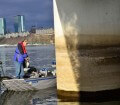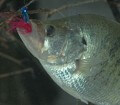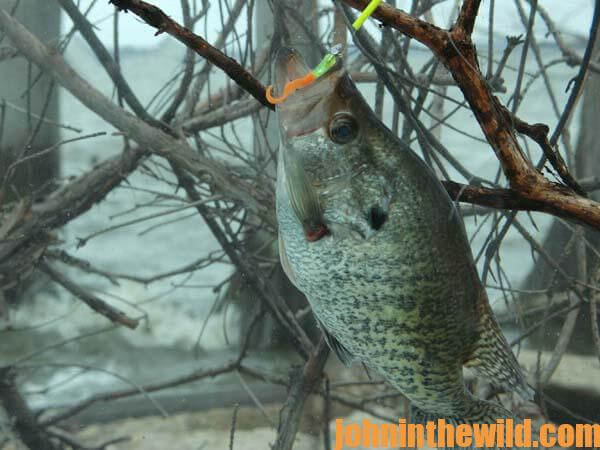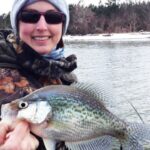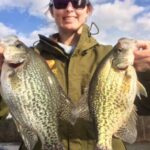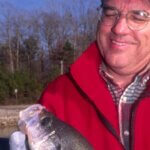John’s Note: During the spring when the weather and the water heat-up, the crappie move into the shallows near the bank to spawn. But oftentimes a late winter cold front can drive the crappie from the banks to open water. Also in many sections of the U.S., the water’s still cold or cool in mid-March to the end of March. As I investigated how to find deep-water crappie not on the banks in the spring and at other times of the year, I learned that the most-consistent place to catch crappie at any time of the year is away from the bank.
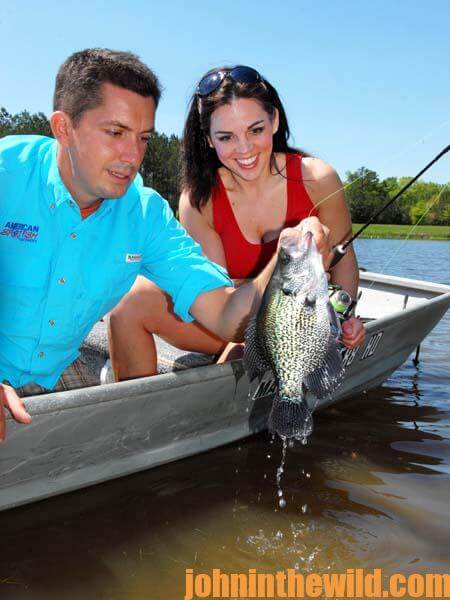 When major impoundments are built, and the water’s backed-up, the structure and the terrain breaks present on the land are submerged. Some of the best underwater, manmade structures that pay-off for crappie fishermen when a lake’s inundated are the highway and the railroad roadbeds underneath the water, which provide bottom breaks that crappie and other fish hold on during different times of the year. Often the railroad roadbeds are the most-productive for several reasons, because they were built high off the ground before the lake was impounded. Then when the water rises, the roadbed is a vertical structure the crappie can hold on during any time of the year. Since railroad tracks often cross streams and creeks, you may find old railroad trestles submerged in deep water where the crappie will hold throughout most of the year. By using a topographical map that shows bottom structure and by talking to residents who lived in the area before the lake was formed, crappie fishermen can locate these old roadbeds and often discover plenty of papermouths.
When major impoundments are built, and the water’s backed-up, the structure and the terrain breaks present on the land are submerged. Some of the best underwater, manmade structures that pay-off for crappie fishermen when a lake’s inundated are the highway and the railroad roadbeds underneath the water, which provide bottom breaks that crappie and other fish hold on during different times of the year. Often the railroad roadbeds are the most-productive for several reasons, because they were built high off the ground before the lake was impounded. Then when the water rises, the roadbed is a vertical structure the crappie can hold on during any time of the year. Since railroad tracks often cross streams and creeks, you may find old railroad trestles submerged in deep water where the crappie will hold throughout most of the year. By using a topographical map that shows bottom structure and by talking to residents who lived in the area before the lake was formed, crappie fishermen can locate these old roadbeds and often discover plenty of papermouths.
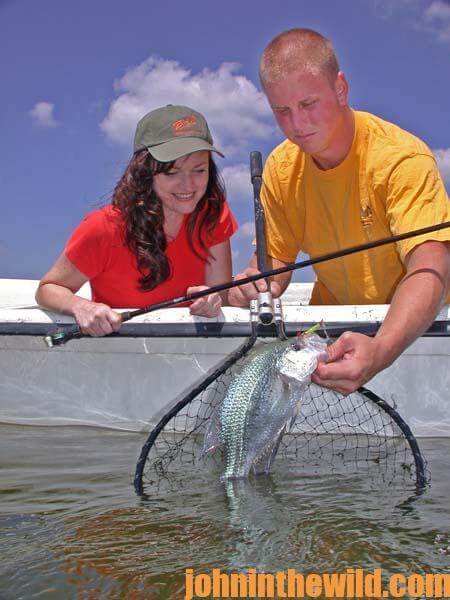 There are three effective methods of pinpointing and catching roadbed crappie. The first tactic involves locating the edge of a roadbed on your depth finder. Place a buoy at the point where the top of the roadbed drops off into deeper water. Next, motor your boat 50 to 100 yards either up or down the lake, find the old roadbed again, and put-out another buoy where the roadbed slopes into deeper water. By motoring your boat in between the buoys and watching your depth finder, you should be able to spot schools of crappie. When you locate a school on your depth finder, drop a buoy to mark that school. Often an angler will discover three or four schools of crappie within 100 to 200 yards of the roadbed he’s buoyed-off. After buoying-off the schools, return to them, and cast jigs or vertically fish for the crappie with minnows. Another crappie technique is to buoy-off the same 100 to 200 yards and troll crappie jigs at the depth where you’ve located the schools of crappie. Although this deep-water tactic for crappie is effective all year, it seems to be the most-productive during the hot summer and the cold winter months.
There are three effective methods of pinpointing and catching roadbed crappie. The first tactic involves locating the edge of a roadbed on your depth finder. Place a buoy at the point where the top of the roadbed drops off into deeper water. Next, motor your boat 50 to 100 yards either up or down the lake, find the old roadbed again, and put-out another buoy where the roadbed slopes into deeper water. By motoring your boat in between the buoys and watching your depth finder, you should be able to spot schools of crappie. When you locate a school on your depth finder, drop a buoy to mark that school. Often an angler will discover three or four schools of crappie within 100 to 200 yards of the roadbed he’s buoyed-off. After buoying-off the schools, return to them, and cast jigs or vertically fish for the crappie with minnows. Another crappie technique is to buoy-off the same 100 to 200 yards and troll crappie jigs at the depth where you’ve located the schools of crappie. Although this deep-water tactic for crappie is effective all year, it seems to be the most-productive during the hot summer and the cold winter months.
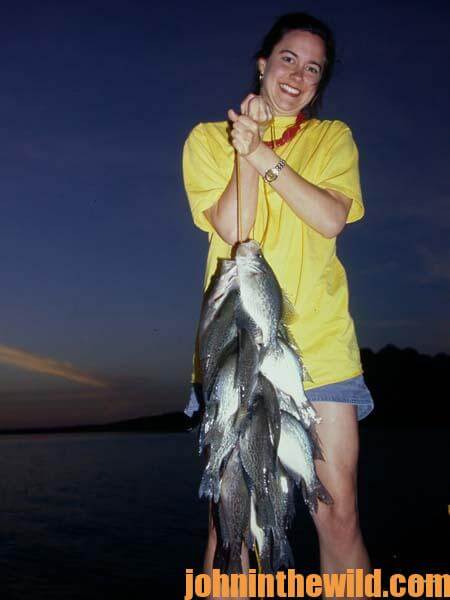 Besides buoying-off and fishing a school or trolling through the schools, angling underwater bridges and trestles can pay-off in papermouth dividends. To consistently catch crappie from this type of underwater structure, the angler mentally must picture the bridge before the water level was raised. Most bridges have some type of steel supports above the roadbed. When crappie are shallow, the crappie often will be suspended in and around those supports. During extreme weather conditions, like the coldest or the hottest weather, the crappie generally will move lower on the submerged bridge and may hold under the bridge where it’s once crossed a creek. Many times when a jig fall right beside the old bridge and passes the old roadbed, an angler can picture in his mind how the crappie will run out from under the shade of that bridge and take their baits. Underwater bridges also have concrete or steel pilings that once supported the old bridge. These underwater pilings are just like the bridge pilings that are above the water in that some of them stand on the edges of an old creek or a riverbank, providing the vertical structure that crappie prefer to move up and down on when water and weather changes cause them to go more shallow or deep. These old underwater bridge pilings also provide current breaks on which the crappie can hold. Therefore, by locating the old bridges and the old rights-of-way, anglers can pinpoint plenty of deep-water structures to take crappie from all year.
Besides buoying-off and fishing a school or trolling through the schools, angling underwater bridges and trestles can pay-off in papermouth dividends. To consistently catch crappie from this type of underwater structure, the angler mentally must picture the bridge before the water level was raised. Most bridges have some type of steel supports above the roadbed. When crappie are shallow, the crappie often will be suspended in and around those supports. During extreme weather conditions, like the coldest or the hottest weather, the crappie generally will move lower on the submerged bridge and may hold under the bridge where it’s once crossed a creek. Many times when a jig fall right beside the old bridge and passes the old roadbed, an angler can picture in his mind how the crappie will run out from under the shade of that bridge and take their baits. Underwater bridges also have concrete or steel pilings that once supported the old bridge. These underwater pilings are just like the bridge pilings that are above the water in that some of them stand on the edges of an old creek or a riverbank, providing the vertical structure that crappie prefer to move up and down on when water and weather changes cause them to go more shallow or deep. These old underwater bridge pilings also provide current breaks on which the crappie can hold. Therefore, by locating the old bridges and the old rights-of-way, anglers can pinpoint plenty of deep-water structures to take crappie from all year.
To learn much more about crappie fishing, get John E. Phillips’ Kindle eBooks and some print books, “Crappie: How to Catch Them Fall & Winter,” “Crappie: How to Catch Them Spring and Summer” and “Catch Cold Water Crappie Now.” Click here to get these books.

